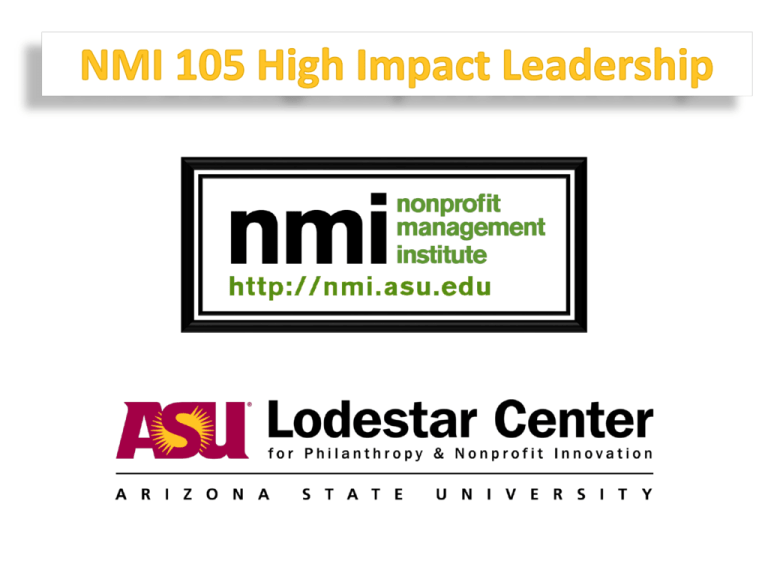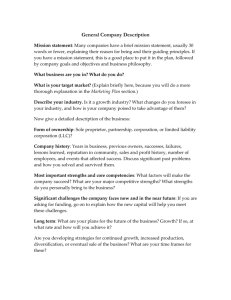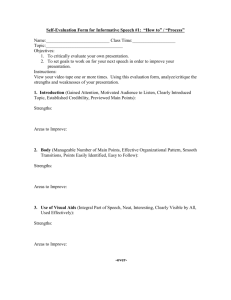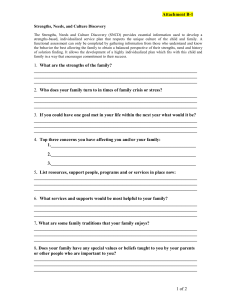
NMI 105 High Impact Leadership
Has led nonprofit organizations for more than 25 years
Recently, led Keogh Health Connection’s growth from one
employee to ten
Has held positions including Counselor, Development Director
and Regional Vice President
Holds a BA in Psychology and Political Science from Concordia
College and a Master’s of Education – Counseling from
Minnesota State University
-2-
-3-
Distinguish key differences between leadership and
management
Describe current models of leadership, including
characteristics of a good leader within each model
Evaluate your own leadership according to the 7
Leadership Competencies
Identify your top 5 strengths as a leader using the
Strengths Based Leadership Strengths Finder
-4-
Identify the 4 Domains of Leadership Strength to build
effective teams
Determine informed ethical decisions as a leader
Develop your personal leadership core values
Develop a leadership action plan with a personal mission
statement
-5-
Pair-Share with a partner you don’t know…
Your name, title, organization
Your answers to the exercise
Discuss discrepancies
-6-
“Management works in
the system and leadership
works on the system”
Stephen Covey
Author of 7 Habits of Highly Effective People
-7-
-8-
Bill Gates, Co-Founder of Microsoft, 1976
Bill & Melinda Gates Foundation, 2000
-9-
http://www.thefamouspeople.com/profiles/images/mahatma-gandhi.jpg
- 10 -
- 11 -
While
they are
there
- 12 -
That
endure
beyond
themselves
- 13 -
Soft
Spoken
Good
Listeners
Humble
Modest
Gentle
Serious
Rather
Shy
Unobtrusive
- 14 -
Thoughtful
Quiet
Level 5 Leadership
Good to Great by Collins
Servant Leadership
Servant Leadership by Greenleaf
Situational Leadership
The Situational Leader by Hersey and One Minute Manager by Blanchard
Emotional Intelligence by Goleman
Exemplary Leadership
Five Practices of Exemplary Leadership by Kouzes and Posner
- 15 -
- 16 -
Executive
• Level 5: Builds enduring greatness through a
paradoxical blend of personal humility and professional
will
Effective
Leader
• Level 4: Catalyzes commitment to and vigorous
pursuit of a clear and compelling vision,
stimulating higher performance standards
• Level 3: Organizes people and resources
toward the effective and efficient pursuit
of predetermined objectives
Competent
Manager
• Level 2: Contributes individual
capabilities to the achievement of
group objectives; works effectively
with others in a group setting
Contributing Team
Member
Highly Capable Individual
- 17 -
• Level 1: Makes productive
contributions through
talent, knowledge, skills,
and good work habits
- 18 -
Achieve results by giving
priority attention to
• The needs of their colleagues
• Those they serve
Are often seen as
Emphasize
• Humble stewards of their
organization's resources
• Human
• Financial
• Physical
• Increased service to others
• A holistic approach to work
• Promoting a sense of community
• Sharing power in decision
making
- 19 -
Listening
Empathy
Healing
Awareness
Persuasion
Conceptualization
Foresight
Stewardship
Commitment
to the growth
of people
Building
community
- 20 -
Successful leaders adapt
their style to the maturity
of the individual or group
they are attempting to
lead/influence
- 21 -
Paul Hersey
Ken Blanchard
The Situational
Leader
One Minute
Manager
• Focuses on personal leadership style, and the development
level of the person being led
Daniel Goleman
Emotional Intelligence
• Focuses on knowing yourself and the motivation of others
- 22 -
Telling
Leader
Delegating
Leader
Selling
Leader
Participating
Leader
- 23 -
Low Competence
High Commitment
Some Competence
Low Commitment
High Competence
Variable Commitment
High Competence
High Commitment
- 24 -
- 25 -
SelfAwareness
SelfRegulation
Social skills
Empathy
Motivation
- 26 -
Situational Leadership
Coaching
Leader
Pace-Setting
Leader
Democratic
Leader
Affiliate
Leader
- 27 -
Authoritative
Leader
Coercive
Leader
- 28 -
Model the Way
Inspire a Shared Vision
Challenge the Process
Enable Others to Act
Encourage the Heart
- 29 -
Describe the
most effective
leader you’ve
known
- 30 -
- 31 -
Vision
Trust
Interpersonal Skills
Results Oriented
Communication Skills
- 32 -
- 33 -
- 34 -
- 35 -
- 36 -
- 37 -
- 38 -
- 39 -
- 40 -
John Kania
& Mark
Kramer
• “Large-scale social change requires
broad cross-sector coordination, yet
the social sector remains focused on
the isolated intervention of
individual organizations.”
• “Collective impact initiatives provide
a structure for cross-sector leaders to
John Kania& Mark Kramer:
forge a common agenda for solving a
specific social
“ problem”
Stanford Social Innovation Review, Winter 2011; Copyright © 2011 by Leland Stanford Jr. University
- 41 -
- 42 -
Executing
Influencing
Making things happen
Selling the team’s ideas
Relationship Building
Strategic Thinking
Creating a team bigger than the
sum of its parts
Keeping the team focused on
what could be
- 43 -
3 Keys to Being a More Effective Leader
The Most Effective Leaders:
1. Are always
investing in
strengths
3. Understand
their
2. Surround
followers’
themselves with needs
the right people
and then
maximize their
team
- 44 -
Focus on result.
Conflict doesn’t
destroy them
Are magnets for
talent
Embrace diversity
- 45 -
Prioritize what’s
best for the
organization and
move forward
Are as
committed to
personal lives as
to work
Four Basic Needs of Those Who Follow
Trust
Stability
Compassion
Hope
- 46 -
Survey
• 177 paired descriptors
• 20 seconds per pair
• 32 min. average completion time
Overnight
• Use personal code in back of book
• Take Strengths Based Leadership
Survey
• Print out results for your Top 5
Strengths and Action Strategies
Reports
- 47 -
What was the
most impactful
thing you
learned today?
What is one
thing you will
put into action
immediately?
- 48 -
- 49 -
Identify the 4 Domains of Leadership Strength to build
effective teams
Determine informed ethical decisions as a leader
Develop your personal leadership core values
Develop a leadership action plan with a personal mission
statement
- 50 -
- 51 -
Executing
Influencing
Making things
happen
Selling the team’s
ideas
- 52 -
Relationship
Building
Strategic
Thinking
Creating a team
bigger than the sum
of its parts
Keeping the team
focused on what
could be
Trust
When you have a team
that trusts the leader, it
optimizes their work and
increases their speed
and efficiency. An
example from the book
states that a ratio of 1:2
people are highly
engaged when they trust
their leader compared
to 1:12 who don’t have a
trusting relationship
with their leader.
Compassion
When people feel that
their leader seems to
care about them as a
person they are
significantly more
likely to stay with the
organization. Also, the
organization has more
engaged customers,
employees are more
productive, and their
products and services
are more profitable.
Stability
Hope
The team feels that
they can count on their
leader in time of need.
The leader has a vision
of hope for the future
and can be counted on
to offer direction and
guidance.
- 53 -
- 54 -
- 55 -
- 56 -
- 57 -
- 58 -
- 59 -
- 60 -
Characteristics
and habits of
others that
frustrate me
- 61 -
Honesty
Keeping Promises
Being my Best
Trust
Happiness
Independence
Integrity
Taking Care of Myself
Competence
Respect
Making a Difference
Intuition
Loving Family
Courage
Compassion
Humor
Collaboration
Autonomy
- 62 -
- 63 -
- 64 -
- 65 -
Leadership Wheel and Planning Document
- 66 -
Leadership Wheel
- 67 -
How will knowing
your personal mission
statement, values
and leadership
strengths change the
way you lead?
What 1 – 2 things
have you discovered
about yourself that
you didn’t know
before?
- 68 -
Copyright © 2012 Arizona Board of Regents for and on behalf of the ASU Lodestar Center for Philanthropy and Nonprofit Innovation, College of
Public Programs, Arizona State University. All rights reserved. No part of this publication may be reproduced, stored in a retrieval system, or
transmitted in any form or by any means, electronic, mechanical, photocopying, recording or otherwise, without the express written permission
of the ASU Lodestar Center, except for brief quotations in critical reviews. The authors may be reached as the ASU Lodestar Center, 411 N.
Central Ave., Suite 500, Phoenix, AZ 85004-0691
- 69 -








